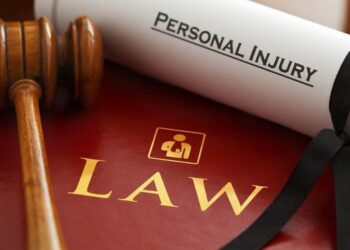Key Highlights
- A workplace wrongful death claim can help families recover financial and emotional losses after a loved one’s death due to employer negligence.
- Common causes of workplace fatalities include falls, equipment accidents, hazardous material exposure, and vehicle incidents.
- Eligible family members can pursue legal action against negligent parties to seek compensation for various damages.
- Consulting an experienced wrongful death attorney is crucial for navigating the complexities of these cases and protecting your rights.
- Understanding the legal framework, gathering evidence, and meeting deadlines are essential steps in filing a successful claim.
The sudden loss of a loved one in a workplace accident is devastating. When such tragedies occur due to negligence, a wrongful death claim can provide a legal path for surviving family members to seek justice and compensation.
This process involves navigating a complex legal system to demonstrate liability and secure financial support for the family’s emotional distress and financial burdens.
Key Elements of a Workplace Wrongful Death Claim
A workplace wrongful death claim alleges that an employer or another responsible party’s negligence or misconduct led to an employee’s death. This legal action aims to hold accountable those whose actions or inactions created unsafe working conditions, ultimately resulting in a fatality.
To prove a wrongful death claim, it is crucial to demonstrate that the responsible parties had a duty to maintain a safe work environment. This includes providing adequate safety training, ensuring proper equipment maintenance, and enforcing safety regulations. Failure to uphold this duty, leading to a fatal accident, forms the basis of a wrongful death claim.
Defining Wrongful Death in the Workplace Context
Wrongful death, in a workplace context, refers to a fatality that occurs due to the negligence or wrongful actions of an employer, coworker, or another party responsible for maintaining workplace safety. Unlike accidental deaths, wrongful deaths arise from preventable situations where established safety protocols or legal duties of care were disregarded.
These deaths stem from various situations, such as unsafe working conditions, malfunctioning equipment, inadequate safety training, or employer negligence in enforcing safety regulations. Understanding this distinction is key for families seeking legal recourse.
Successfully proving a wrongful death claim hinges on establishing that the employer or another responsible party failed in their duty to provide a safe work environment, directly resulting in the employee’s death. Families of the deceased may then be entitled to compensation for their losses.
Essential Criteria for Filing a Claim
Several criteria are essential to establish grounds for filing a wrongful death claim. Firstly, the claimant needs to prove that the death was a direct consequence of another party’s negligence or wrongful actions. This requires a thorough investigation into the circumstances of the workplace accident to establish a clear causal link between the responsible party’s actions and the fatality.
Secondly, the deceased person must have been employed by the company or entity at the time of the incident that led to their death. This employment relationship establishes the legal duty of care owed by the employer to the employee.
Finally, surviving family members must demonstrate that they have suffered damages – both economic and non-economic – as a result of the wrongful death. These damages can include lost wages, loss of companionship, and emotional distress, among other things.
Common Causes of Workplace Fatalities
Workplace fatalities often result from a combination of factors, including employer negligence, inadequate safety measures, and hazardous working conditions. Recognizing these common causes is crucial in preventing future tragedies and ensuring employers prioritize worker safety.
Falls from heights, equipment malfunctions, exposure to hazardous materials, and vehicle accidents are among the leading causes of workplace fatalities. These incidents highlight the importance of stringent safety protocols, regular equipment maintenance, and comprehensive employee training programs.
Equipment-Related Accidents
Equipment-related accidents in the workplace often lead to serious injuries and, tragically, even fatalities. Such accidents expose the critical need for robust safety protocols and adherence to Occupational Safety and Health Administration (OSHA) regulations.
OSHA sets and enforces workplace safety standards to mitigate risks and prevent accidents. These standards encompass various aspects, including equipment design, maintenance, and worker training, all of which play a significant role in ensuring workplace safety.
Employers must prioritize regular equipment inspection and maintenance, provide adequate worker training on safe operating procedures, and promptly address any reported malfunctions to minimize the risk of equipment-related workplace accidents.
Exposure to Hazardous Substances
Exposure to hazardous substances in the workplace poses significant risks to employees’ health and safety. Industries that handle chemicals, radioactive materials, or other potentially dangerous substances must adhere to stringent safety regulations to prevent personal injury or fatalities.
Employers have a legal obligation to inform employees about the potential hazards associated with the substances they handle, provide adequate safety training, and supply appropriate personal protective equipment. Failure to comply with these obligations can lead to serious health consequences, including long-term illnesses and, in some cases, death.
When employers neglect their responsibilities regarding hazardous materials handling, they expose their workers to unnecessary risks. If an employee’s death results from such negligence, a wrongful death claim can hold the employer accountable and seek justice for the deceased worker’s family.
Vehicle and Transportation Incidents
Vehicle and transportation incidents contribute significantly to workplace deaths, particularly in industries involving driving or operating heavy machinery. These incidents often lead to wrongful death lawsuits when negligence is a contributing factor.
Employers are responsible for ensuring that employees operating company vehicles are properly licensed, trained, and adhere to all traffic regulations. Furthermore, regular vehicle maintenance and inspections are crucial to prevent accidents caused by mechanical failures.
When a workplace death occurs due to a vehicle or transportation incident, a thorough investigation is essential to determine the cause and identify any potential negligence. If an employer’s failure to maintain safe transportation practices contributes to the fatality, they can be held liable through a wrongful death lawsuit.
Who Can File for Death Benefits?
In the aftermath of a workplace fatality, specific family members are eligible to file for death benefits. These benefits aim to provide financial support to the deceased worker’s dependents who have suffered financial losses due to their loved one’s passing.
Typically, immediate family members, including spouses, children, and financial dependents, have the right to pursue death benefits. The specific eligibility criteria and amount of benefits available vary depending on state laws and the deceased worker’s employment details. It’s crucial for families to consult with an experienced wrongful death attorney to understand their rights and explore all available legal options.
Legal Framework Surrounding Wrongful Death Claims
Navigating the legal framework surrounding wrongful death claims requires a thorough understanding of applicable state and federal laws. These laws establish guidelines for filing a claim, determining liability, and calculating the amount of compensation that surviving family members may receive.
Georgia and California law, for example, allows certain family members to file wrongful death lawsuits to seek damages such as lost wages, loss of companionship, and emotional distress. Consulting with an experienced attorney specializing in wrongful death cases is crucial to navigating these complexities and protecting your legal rights.
The Role of OSHA in Workplace Safety
The Occupational Safety and Health Administration (OSHA) is a federal agency that plays a vital role in ensuring workplace safety across various industries. OSHA sets and enforces safety protocols aimed at minimizing workplace hazards, preventing accidents, and protecting employees from injury or death.
Through rigorous inspections, investigations, and enforcement actions, OSHA holds employers accountable for maintaining safe working environments. Their regulations cover a wide range of workplace safety aspects, from equipment standards and hazardous material handling to fall protection and employee training requirements.
In cases of workplace fatalities, OSHA investigations often shed light on potential safety violations that contributed to the incident. These findings can serve as valuable evidence in a wrongful death claim, demonstrating employer negligence and strengthening the family’s case for compensation.
Steps to Filing a Workplace Wrongful Death Claims
Navigating the aftermath of a workplace fatality is emotionally challenging, but it is crucial to act swiftly to protect your legal rights. Seeking guidance from a seasoned wrongful death attorney and understanding the steps involved in filing a claim can help alleviate some of the burden during this difficult time.
Gathering necessary documentation, including accident reports, medical records, and employment information, is paramount. Your attorney will work diligently to build a compelling case while you focus on healing and supporting your family.
1. Seek Legal Counsel
Navigating the complexities of a wrongful death claim requires expertise and legal guidance. Seeking legal counsel from an experienced wrongful death attorney should be your first step. A skilled attorney can provide invaluable support, protect your rights, and guide you through the legal process effectively.
During a free consultation, an attorney will assess your case, explain your legal options, and outline the necessary steps to pursue a claim. They will investigate the incident thoroughly, gather evidence, and build a strong case to establish liability and maximize compensation for your family’s losses.
Remember, time is of the essence in wrongful death cases. Therefore, consulting with an attorney as soon as possible is crucial to protect your legal rights and ensure that you meet all necessary deadlines.
2. Gathering Evidence and Documentation
Building a strong wrongful death claim hinges on presenting compelling evidence that supports your allegations of negligence or misconduct. This involves meticulous gathering of various forms of documentation to establish a clear narrative of the events leading to the fatal incident.
Essential evidence includes accident reports, medical records, witness statements, photographs, and videos of the scene, and any relevant safety regulations or company policies. Your attorney may also consult with expert witnesses, such as accident reconstruction specialists or medical professionals, to provide expert opinions that bolster your claims.
The strength of your claim relies heavily on the quality and comprehensiveness of the evidence presented. Therefore, working closely with your attorney to collect all necessary documentation is crucial to building a persuasive case.
3. Notify Relevant Parties
Informing relevant parties about workplace fatality is crucial when pursuing a wrongful death claim. This step ensures that all responsible parties are aware of the incident and the potential legal action.
Start by formally notifying the deceased worker’s employer and their insurance company about the fatality. This notification should be in writing and provide details about the incident, including the date, time, and location, as well as the deceased worker’s name and job title.
Depending on the circumstances, you may also need to notify other relevant parties, such as property owners, equipment manufacturers, or contractors who were involved in the project or activity where the fatality occurred. Timely notification ensures that all potentially liable parties are informed and allows for a smoother legal process.
4. Determine the Claim Type
When pursuing legal action after a workplace fatality, it’s crucial to determine the appropriate claim type based on the specific circumstances. Depending on the nature of the incident and the parties involved, you might have several options, including a wrongful death claim, a workers’ compensation claim, or a personal injury lawsuit.
A wrongful death claim seeks compensation from a party whose negligence or wrongful actions caused the death. On the other hand, a workers’ compensation claim typically provides benefits to employees injured or killed on the job, regardless of fault.
In some instances, you might also have grounds for a personal injury lawsuit, especially if a third party, such as a product manufacturer or property owner, contributed to the fatal accident. Consulting with an experienced attorney will help determine the most appropriate legal strategy for your case.
5. File a Claim
Once you have gathered all necessary evidence, determined the appropriate claim type, and notified the relevant parties, the next step is to formally file a claim. This involves preparing a legal complaint that outlines the details of the incident, the legal basis for your claim, and the damages you are seeking.
Your attorney will handle the filing process, ensuring all necessary documentation is included and filed within the prescribed statutory deadlines. Each state has its own statute of limitations for filing wrongful death cases, so acting swiftly is crucial to avoid jeopardizing your legal rights.
Remember that filing a claim is a formal legal action that initiates the litigation process. From this point forward, you can expect communication and negotiations with the opposing party’s legal representation, which your attorney will handle on your behalf.
6. Negotiate
After filing a wrongful death claim, negotiations with the responsible party’s insurance company typically ensue. This stage involves back-and-forth discussions and offers aimed at reaching a fair settlement that compensates the surviving family for their losses.
Your attorney will advocate strongly on your behalf, using their expertise and the strength of the evidence gathered to negotiate for the best possible outcome. They will carefully consider factors such as lost income, loss of companionship, emotional distress, and other damages when determining what constitutes a fair settlement.
Negotiations can be complex and lengthy, but your attorney will guide you through the process, keeping you informed of any developments and advising you on the best course of action at every stage.
7. Litigation (if necessary)
In the unfortunate event that a workplace wrongful death claim leads to litigation, it becomes crucial to navigate the legal process efficiently. Litigation may be necessary to seek punitive damages, especially in cases involving intentional actions or gross negligence. Expert witnesses play a significant role in establishing liability. An experienced wrongful death attorney can guide family members through the complex legal proceedings to ensure the best possible settlement that aligns with the family’s interests. It is essential to consider all aspects of the case and pursue the rightful compensation under the law.
8. Collect Compensation
The ultimate goal of a wrongful death claim is to secure rightful compensation for the surviving family members. This compensation serves as a form of financial support to address the losses they have endured due to their loved one’s passing.
If the court rules in your favor or a settlement is reached, you will receive financial compensation for various damages, including lost income, medical expenses, funeral costs, loss of consortium, and pain and suffering.
Obtaining full compensation is crucial in providing the family with the resources needed to rebuild their lives after a tragic loss. An experienced attorney will work diligently to ensure you receive every penny you deserve.
Compensation and Damages in Wrongful Death Cases
Understanding the types of compensation available in wrongful death cases is essential for families seeking to rebuild their lives after a tragic loss. Damages in such cases are typically categorized as economic and non-economic, aiming to address both tangible and intangible losses.
Economic damages encompass financial burdens, such as lost wages, medical expenses, funeral costs, and loss of inheritance. Non-economic damages are harder to quantify but equally important, addressing emotional distress, loss of companionship, and grief experienced by surviving family members.
Types of Damages Awarded
In wrongful death cases, courts often award various types of damages to compensate the surviving family members for their losses. These damages are classified as economic, non-economic, and, in some cases, punitive damages.
Economic damages refer to quantifiable financial losses incurred due to the death. These can include:
- Lost wages and benefits: Compensation for the income the deceased would have earned had they not died.
- Medical Expenses: Reimbursement for medical bills incurred before the death, including hospitalization, surgery, and medication.
- Funeral and burial costs: Payment for expenses related to funeral arrangements, burial, or cremation.
Non-economic damages address less tangible losses, such as:
- Loss of companionship and consortium: Compensation for the emotional support, love, and companionship the deceased provided.
- Emotional distress and grief: Payment for the mental anguish and suffering experienced by surviving family members.
- Loss of inheritance: Compensation for the expected inheritance that heirs would have received had the deceased lived a full life expectancy.
Punitive damages, while less common, are intended to punish the defendant for particularly egregious conduct.
Calculating Economic and Non-Economic Damages
Calculating damages in wrongful death cases is a complex process that takes into account various factors to determine an appropriate amount of compensation. Economic damages are generally easier to calculate as they involve tangible financial losses.
For instance, lost wages are calculated based on the deceased person’s age, work history, earning potential, and life expectancy. Medical expenses are determined from medical bills and records, while funeral costs are based on actual expenses incurred.
Non-economic damages like emotional distress and loss of companionship are more subjective and challenging to quantify. Courts may consider factors such as the relationship between the deceased and the surviving family members, the deceased person’s age and health at the time of death, and the circumstances surrounding the death to determine an appropriate amount for non-economic damages.
Workers’ Compensation
Worker’s compensation is a system designed to provide financial relief to employees who suffer work-related injuries or illnesses. When a workplace accident results in a fatality, surviving family members may be eligible for death benefits through workers’ compensation.
These death benefits typically cover funeral expenses and provide ongoing financial support to dependents. However, it is important to note that worker’s compensation claims generally bar families from filing lawsuits against the employer, even in cases of negligence.
This aspect highlights the need to consult with an experienced wrongful death attorney who can assess the specifics of the case and advise on the most beneficial legal avenues to pursue maximum compensation.
Conclusion
In conclusion, workplace wrongful death claims involve complex legal processes that require thorough understanding and careful navigation. From defining wrongful death in a workplace context to determining compensation and damages, each step demands attention to detail. Seeking legal counsel, gathering evidence, and following the right procedures are crucial for a successful claim.
Understanding state and federal regulations, as well as the role of OSHA, is essential in ensuring justice for the deceased and their family. By knowing your rights and responsibilities, you can navigate the challenges of workplace wrongful death claims with confidence and diligence.
Frequently Asked Questions
What is the Statute of Limitations for Workplace Wrongful Death Claims?
The statute of limitations is a crucial legal term that sets strict time limits for filing lawsuits. In California, the relevant statute for workplace wrongful death claims generally allows two years from the date of death to file a lawsuit. It’s essential to consult an attorney promptly to avoid missing these critical deadlines.
Can Family Members Sue for Punitive Damages?
While less common in wrongful death lawsuits, California law does allow family members to seek punitive damages in certain circumstances. These damages are awarded to punish the defendant for particularly egregious or intentional actions but require a higher burden of proof.
How Does Workers’ Compensation Affect a Wrongful Death Claim?
Accepting workers’ compensation benefits may impact your ability to file a separate wrongful death claim against the employer. However, you may still have options against third parties. It is crucial to consult an attorney to navigate this intricate legal process.
What if the Deceased Was Partially at Fault?
California follows the principle of comparative negligence, which means even if the deceased was partially at fault, their family may still recover damages but in a reduced amount proportional to the deceased’s share of responsibility.
How to Choose the Right Attorney for Your Wrongful Death Claim?
Choosing an experienced wrongful death attorney who prioritizes your family’s best interests is crucial during this challenging time. Seek an attorney specializing in these claims, offering a free consultation, compassionate guidance, and a strong track record of success.










